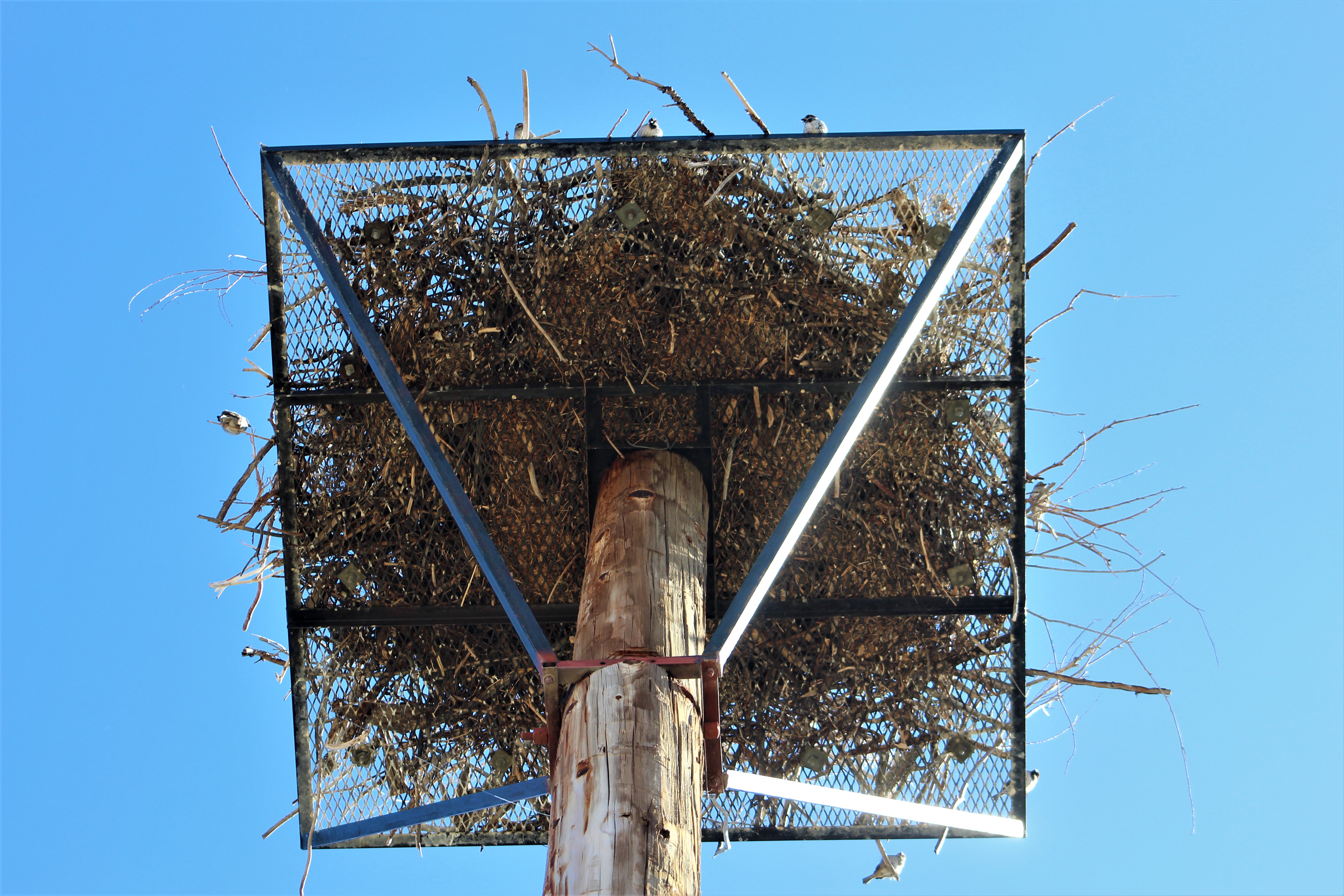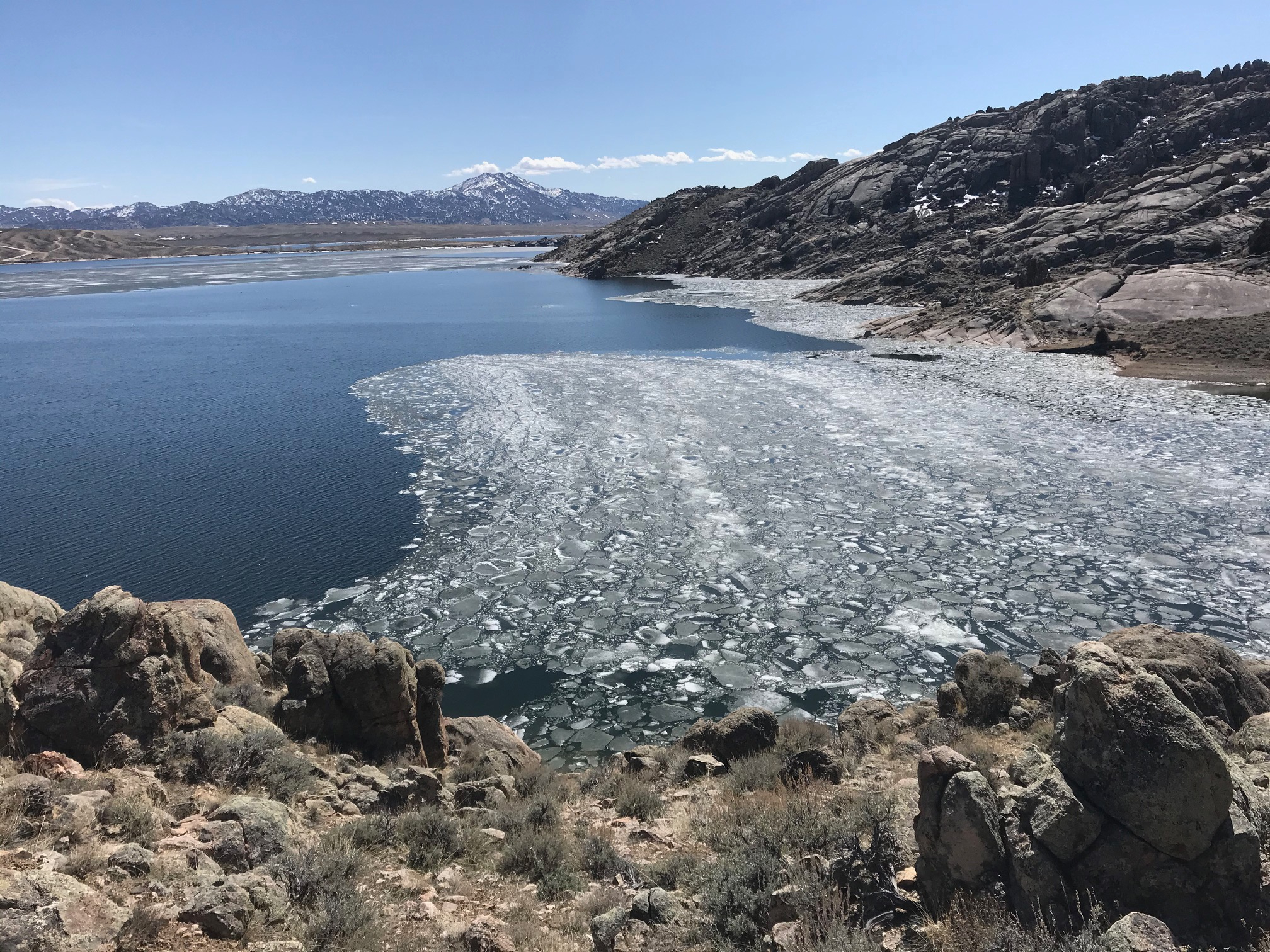The day after John Prine died, I drove out to the stretch of river between Alcova Dam and Grey Reef Reservoir to check on a pair of ospreys I had seen two weeks before. The first time I saw them, the female was tending the nest, while the male was fishing the slides and turnouts along the public stretch. In four tries, the male osprey dove and came up with four trout. These he took back to the nest where the female greeted him with much ruckus and ragged wing beats. These were not small fish, and it seemed unbelievable that the pair of ospreys could eat that many trout.
Ospreys are migratory birds. You won’t see them in Wyoming in the winter. They migrate south, as far as the Gulf of Florida, and even into Mexico. They return to Wyoming right as the fish are moving into the shallow water to spawn. Their nests are messy puzzles of sun-bleached sticks that appear thrown together, but are completely engineered to withstand big gusts of wind, and to protect the clutch of young fish hawks. These nests can weigh up to 300 pounds. A great example of an osprey nest sits atop a platform beside the road in Alcova, and I’ve relied on this area to watch ospreys each spring. With astounding regularity, there is always a breeding pair that shows up in the spring to fish.
My inability to identify mountain wildflowers is matched only by my inability to identify birds. But I do pretty well with waterfowl and birds you find around rivers. I can watch water ouzels dip for aquatic insects for hours. The first time I saw one was on the Middle Fork of the Powder River. Hooded mergansers, Great Northern Loons, swans, killdeer and Ferruginous Hawks, are some of the charismatic species I often encounter in Natrona County. But the osprey stands out among them. At Alcova you can observe their unique “sky dance” as they go through their spring rituals. Or you can sit and watch as they pin back their wings and snatch a trout from the water. Some of these trout are the very same fish that refused your fly for over two hours. Suddenly, the fish is aloft, firmly gripped in the great bird’s talons, heading to meet its demise.
I met Bill Mixer at the dam and tried to snap a few photos of the pair. (We drove separately to follow the governor’s recommendations.) The female osprey was in a tree by the schoolhouse, shuttered by the recent coronavirus. The male was perched on a towering power line pole eating a fish. I walked under the nest and looked up. In mid-April it’s still too early for young ospreys to hatch. But I could see where the birds had done some recent construction to the nest, and I found the whitened skulls of trout littering the sage underneath the platform. There were dozens of spines, too. Bill said the female was coming. I turned and aimed my camera skyward to catch her gliding toward us. I snapped away, but getting an osprey on film is not easy.
We decided to go over to the reservoir to cast to some trout. The big rainbows in the reservoirs can’t spawn as there is no moving water to have successful spawning. Nevertheless, they go through the process of building redds and guarding their nests. This is an example of what scientists call fixed behavior. “False Spawning” is what it’s called in my circles.

The radio station from Laramie was paying tribute to Prine. The DJ played some of the more recent work. John Prine’s songs of everyday people struggling to live authentic lives seemed to fit the scrubby landscape, the rolling hills just outside of Alcova. He wrote about fishing. He wrote about heartache. “The Glory of True Love” was playing, but it became static and I lost his voice as I entered the red rock canyon country between Alcova and Pathfinder.
There were fishermen out along the Cardwell section. The dam at Pathfinder was so iced in that we decided to look elsewhere. At the boat ramp we discovered a Game and Fish technician preparing to stock the reservoir.
“Looks like we’re right on time,” I said.
“You’re going to be sorely disappointed when you see what I’ve got in here,” said the man. He told us that he was stocking the reservoir with over 17,000 kokanee salmon fry, all about two and half inches long. He asked Bill if he wanted to “pull the plug”, but Bill was more interested in pretending to cast into the frothy tumult of tiny fish as they poured from the tank and into Pathfinder. I pretended to point, the way I’ve seen guides point at bonefish in the fly-fishing magazines I read.
The fry spilled into the icy water. Most settled near the bottom. They formed a school and headed off along the shoreline. But a few hundred were stunned by the cold water, or the sudden change in scenery. These fluttered across the lake’s surface. Immediately, seagulls, mergansers, and loons seized the opportunity and began to feed on the fish. The man from Game and Fish shook his head gravely.
“Most of these will probably get eaten by walleye and trout anyway,” he said. “Pathfinder is a tough place.” He shrugged.

Bill and I hiked back into the landscape. We talked about John Prine and other musicians we liked as we boulder-hopped and worked our way into a calm cove. We saw shapes of fish gliding along the rocky shoreline. But they turned out to be huge mirror carp, and despite our efforts, these fish would not take a fly, even when we dragged our wooly buggers right beneath their noses.
But there were trout around, big, brilliant lake specimens that seemed willing to eat just about anything we cast to them. We caught them on balanced leeches, on glo-bugs, on nymphs and on smaller streamers. I told Bill about some ospreys I used to watch when I lived in Colington Harbor, on the Outer Banks of North Carolina. I worked at a Pizza Hut and was saving money so I could go to graduate school. Those birds snatched seatrout out of Pamlico Sound in the same manner the pair at Alcova snatched rainbows.
A light breeze pushed the remnants of this winter’s ice into our cove. Pretty soon there was more ice than open water, and in a half hour we had nowhere to cast. We saw the sleek shapes of carp and trout moving below the leftover ice, but there was nothing to do but hike back to our vehicles.
I checked the nest on my way home. Both ospreys must have been out fishing. The radio was still mostly static so I couldn’t hear any Prine, but that’s okay, because I knew so many of those old songs I could nearly hear them in my mind. The sign said 29 miles to Casper.




